It is surely no accident that Halloween in Canada and the Day of the Dead in Mexico (November 1st and 2nd) happen in the exact middle of Fall.
By Mark Fenton
Published November 25, 2016
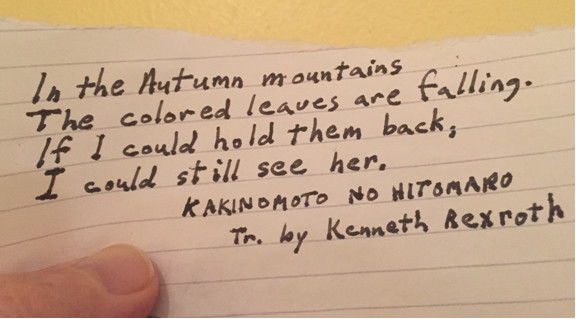
I left my apartment just before sunset and walked at a leisurely pace to see F.W. Murnau's 1927 film, Sunrise. I was glad of such an event to fill my time, since my friend, referred to throughout this piece as 'X', had recently departed for Mexico on business.
Yes, I realize that referring to my friend as X sounds like something out of a French novel from the '50s, but I tried out pseudonyms like Dulcinea, Proposition 2.03, Trump, person-fluent-in-Spanish (abbreviated to PFS), and The Weeknd, and none of them improved the flow.
I myself would be going to meet X in Mexico but in the meantime I was keeping busy in a colourful Hamilton Fall.
Now personally I feel that photos taken in autumn light can only be sinister, regardless of the day's beauty. It is surely no accident that Halloween in Canada and the Day of the Dead in Mexico (November 1st and 2nd) happen in the exact middle of Fall.
Here, for example the vanishing point of the most benign street becomes the impending prison of winter.
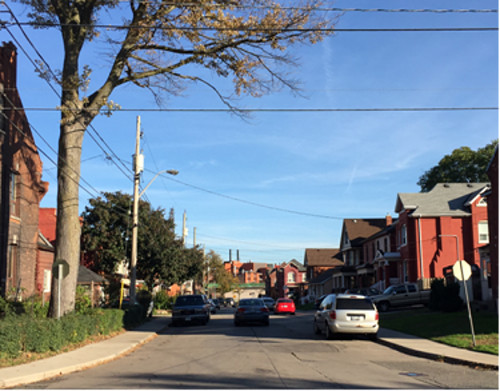
And here a malign tendril whips out of the ground,
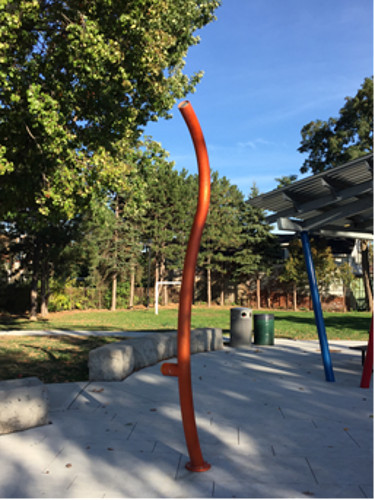
a stern warning that we are the earth's servants, not its masters.
It interested me that pianist and composer Robert Bruce would be accompanying Sunrise with his own score and when I arrived at the venue
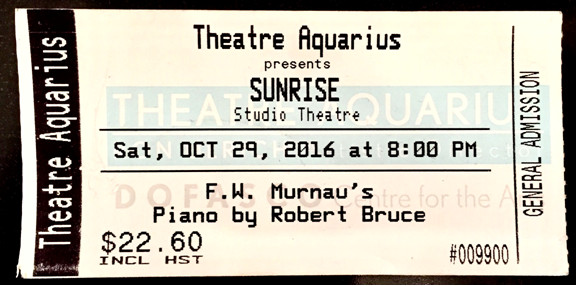
I took this unimaginably bad photo of him.
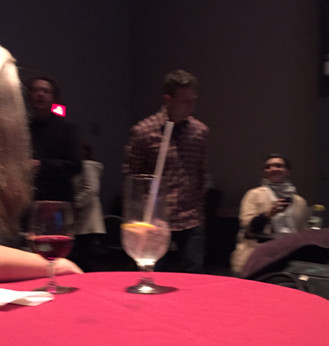
No, he's not the man in the centre of the shot receiving an accidental tracheotomy from a cocktail straw, he's the figure at left in the distance, blurred as if he's overwhelmed by pre-performance nerves.
Though really the pre-performance nerves and attendant camera shake are mine. I am conscious of being the only person here who's come alone-X being in Mexico - and I'm drawing still more attention to my lonely-guy status by tripping over cords and taking conspicuous and inexplicable photographs.
Incidentally I have no idea what the white heart shape on hot pink backdrop above Robert's left shoulder is. It would be great if this was his pre-valentine's performance (more on that below), not his pre-Halloween performance, but it isn't and a photographer can only use what the world gives a photographer.
If you haven't seen Sunrise, here's what happens. (If you dislike spoilers for silent films that only film geeks would ever watch, know that spoilers follow and know that you are an unusual person).
A rude and vigorous farmer referred to as The Man (it's that kind of movie and I'm feeling less self-conscious now about naming a character in this essay 'X') has grown tired of his wife and has begun a rather brutish (to my 2016 eyes) relationship with a "Woman From the City."
What makes her 'from the city' is that she wears lots of makeup and has fashionable flapper era clothes. The man and his wife ('The Woman.' I think we're done with the dramatis personae now) live near the water, so the solution is simple. The Man will take The Woman out in a boat, ostensibly for quality couple time, and drown her. (Because that always works, killing your wife so that you can have unending, impediment-free happiness with your mistress.)
It's actually The Woman from the City who plants this seed which I think makes her, to use a term that's old school and sexist and cringe-inducing, a femme fatale. They're lying by the water as she tempts him with the prospect of fleeing to the city, and here we get one of the film's many double exposures (an effect early cinema loves, the way the 60s movies love the fast zoom).
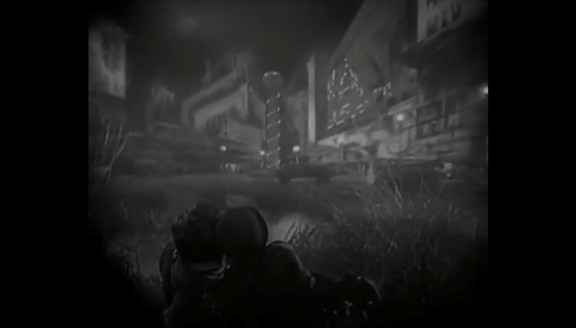
I like how it comes out on my iPhone screenshot with the black at the edges. It's as though I'm watching it in a darkened cinema. The Man and the WFTC look like they're making out in the grassy foreground of a rural drive-in. And on screen they're seeing what looks like the Cineplex in a suburban power centre (there's even a truck searching for a place to park).
The Escher-loop of my imagination goes further and imagines the inside of that Cineplex with the audience watching a rerelease of Sunrise scored for orchestra by Robert Bruce in state-of-the-art digital sound. And at this very moment on the screen a young couple are seeing...ad infinitum.
But back to the narrative. The Man stops rowing, stands, and looms above The Woman, violating a basic principle of boat safety.
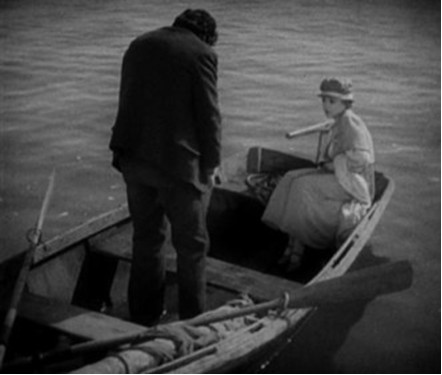
She cowers in terror. After quite a lot of screen time, conscience and good sense win. The man sees the horror of his intentions and abandons the plan.
I am writing this on 11/9/2016 and it takes some effort to resist making this frame a metaphor for yesterday's U.S. election. Early today in the pocket of a coat I was washing in anticipation of winter I found the scrawled transcription of the Hitomaro/Rexroth poem that heads this section. I share the poem's desire to hold back the falling leaves so that 01/20/16 never arrives.
Unsurprisingly The Woman runs for it as soon as they hit land, finding sanctuary on a light-rail car headed for the city. The Man is right behind and jumps on after her and soon they're in the frenetic modern city (paradoxically the home of her nemesis the WFTC who's still stuck out by the farm. That's weird.)
The rail-car provides a natural tracking shot with lots of counterintuitive and snakelike shifts of angle and Hamilton city council should be shown this scene to demonstrate just how scenic and fluid and efficient LRT can be.
Here's where the film loses me. It seems The Man's murder attempt was just the catharsis the couple needed to reignite their passion for one another. (!?) They are now so overcome with neo-adolescent ardor they fall into shameless osculation in the midst of the city's busiest intersection.
Cars screech to a halt from all directions honking and shouting in indignation. A text panel bearing the words "Hey you two, get a room!" doesn't appear only because the oral content is self-evident (I thought maybe Robert Bruce should shout these words out and offer other similar vocal extemporizing throughout the film. If he could do that and maintain the pianistic flow he'd build an auditoria-scale fanbase. Or he would if everyone were me.)
This unexamined romantic interlude is the film's biggest problem. It's too long and gives the audience too much time to ponder the implications. Reader, please, if you narrowly escape murder by your partner do not confuse an adrenaline rush with lasting compatibility.
The film ends with a storm at sea where The Man has to save The Woman from death by water, which is, like, a neat psychological twist since he wanted her death by water a few hours ago. I would have played this for laughs but the movie sure doesn't.
Despite the faults I've highlighted, when the lights come up, I find I do like the film. If the film won't hold up under dissection in a gender studies class, it has a lyrical dreamlike quality communicated mostly by visual style, a topic on which I submitted a bland undergraduate essay back in the '80s when I still believed film study was serious business on the level of those students in the next building learning how to be surgeons.
But the film is beautiful. Shots of the city
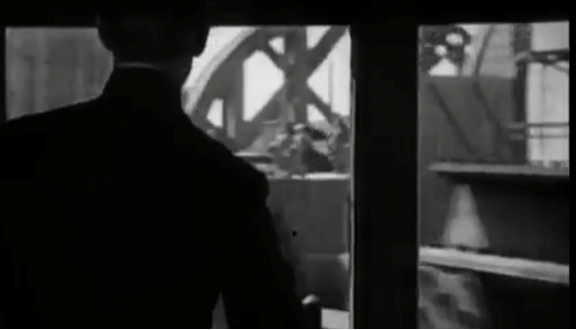
emulate the modernity of a Fernand Léger,
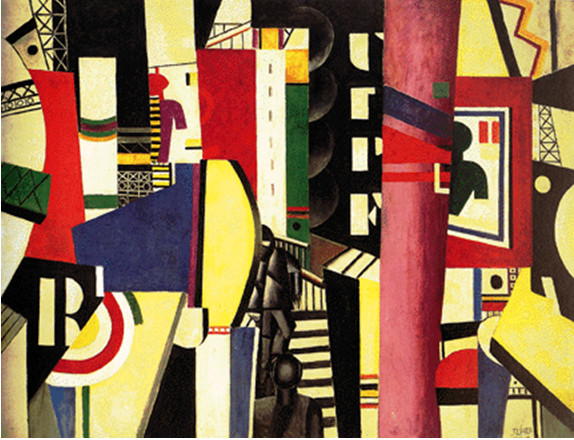
'La Ville,' 1919
the country nightscapes
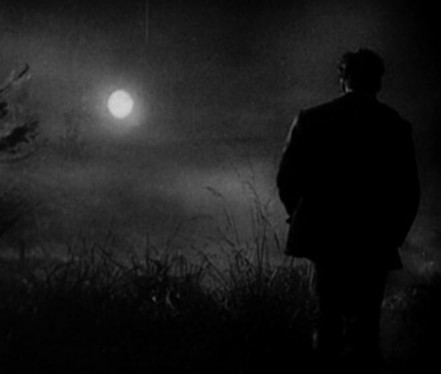
have the faux-painterly expressionism of Edward Steichen's photographs.
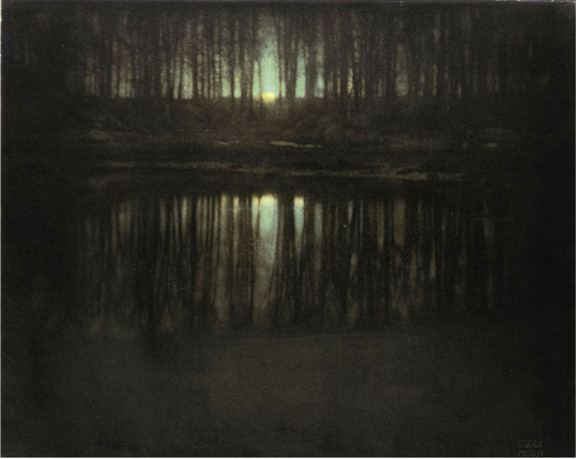
'The Pond-Moonlight,' 1904
But more importantly, in a lifetime of movie going, tonight is the first time I've seen a film from the silent era accompanied by live music.
And here in a rare moment of Raising the Hammer non-obliquely, I'd like to give a huge shout-out to Robert Bruce. His playing is flawless, and he captures the essence of the silent film pianist. He adjusts to the mood of the scene at the moment, but the music is never so in period that the event becomes a museum piece.
Like all art of the past, silent films and how we put them in the context of our lives evolve with the world around us. Robert's music understands this.
My personal discontents with the film were clearly resolved, since my after photo of Robert is in focus. Note that he's dressed not dissimilarly to The Man in Sunrise. And there were moments where he loomed over the keys like an adversary, which dramatic pose I can only assume he intended.
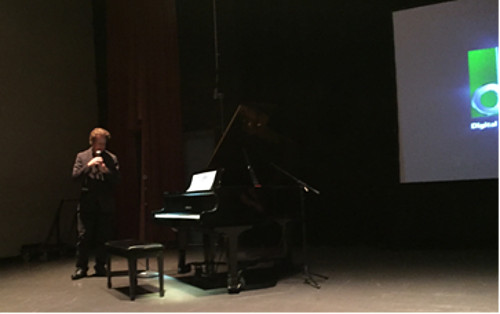
He does these performances regularly and I urge you to check out his presentation of Buster Keaton's "The Cameraman" on February 11, 2017.
I left Theatre Aquarius and headed west down King William. A skinny teen boy and a woman I assume was his guardian (though she didn't look as much older as she should have been) were coming out of the police station.
The woman was in mid-tirade: "You know why you got arrested. You left the scene of an accident. You're in big shit now." The young man answered: "The guy pulled a knife on me," after which I was out of earshot.
The exchange reminded me that life is melodramatic, that motives and truths are impossible to nail down, and the craziest movie drama is far more plausible than what happens to real people in a day, and, as the sign of a tavern a few blocks north after I turned up John Street told me...
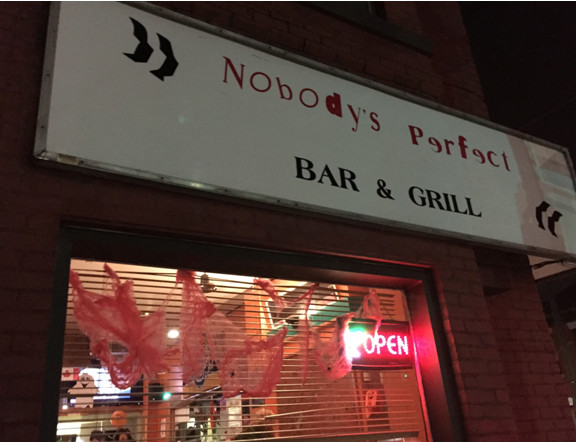
My last photo of the night is an ascent up the John Street overpass of the train track, where I must have been striving for a Steichen nightscape.
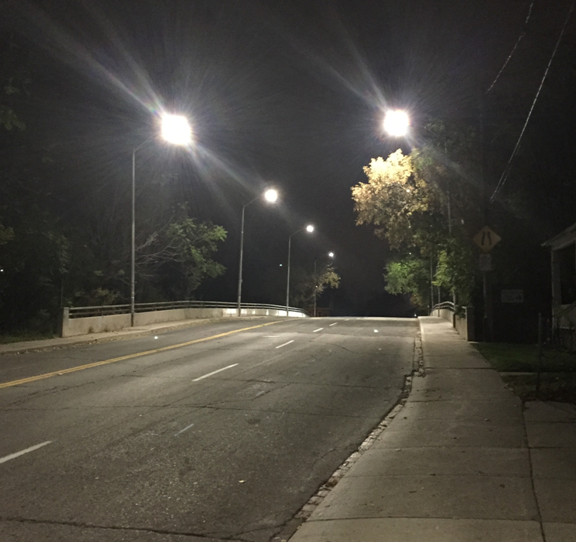
Part 2 will describe an ascent unto death.

Octavio Paz, The Labyrinth of Solitude
I could have typed out the above passage which would have given the quotation conventional limits and lost the "ripped from a page" effect. It's from a pre-digital Grove Press edition, and I really like those slightly uneven lines of text with their organic leading and kerning, like the skeleton of a vanquished technology.
It was shortly before Day of the Dead and I was in Guanajuato and X was taking me to the Mummy Museum. Yesterday I did not know a Mummy Museum existed, and now I was trekking to it as though it housed my grail.
Our base in this town was virtually the last bookable room in Guanajuato. It is a week of the Festival Internacional Cervantino, a huge arts festival named for Miguel de Cervantes. This being the 400th anniversary of Cervantes' death, it's a bigger deal even than usual and the town is booked solid.
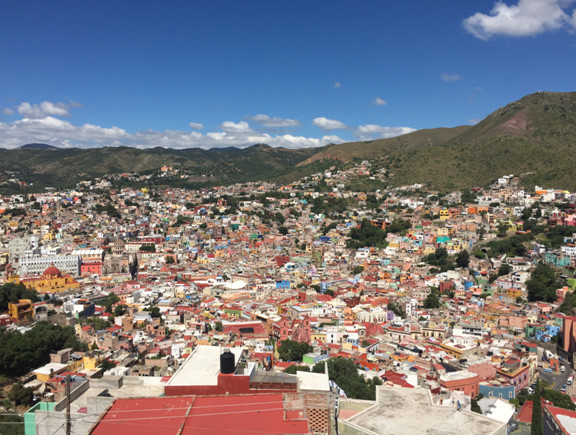
Yes, it's a great view. But every trip down into the town involves a trip back up, turning each excursion into a 'do-you-really-want-to-risk-cardiac-arrest-again?' throwdown. Apt enough for where we're going.
The climb down is hard on the knees. The return is hard on everything else. A long, cobbled and narrow road, followed by a left turn onto steps tapering to an unthinkable vanishing point. And when the hotel property is actually reached there's a final batch of steps
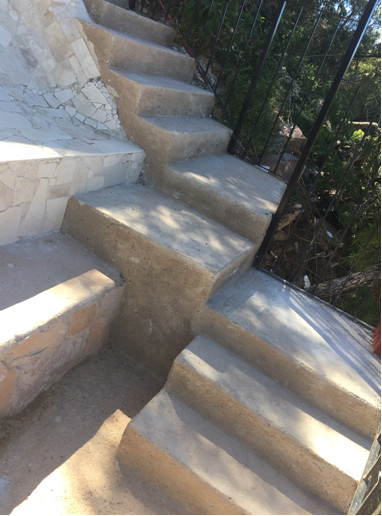
resembling those steps in Escher drawings that promise a destination but provide only a treadmill.
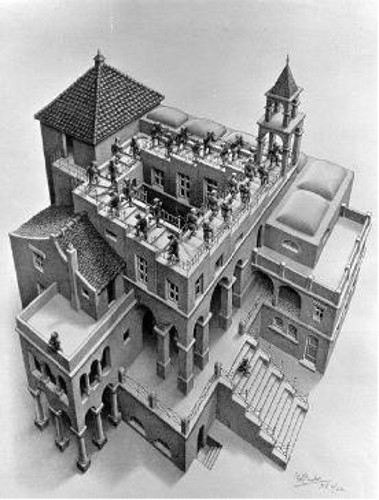
'Ascending and Descending,' M.C. Escher, 1960
So as you can imagine the prospect of climbing to a museum I'd never heard of in order to see dead people, and then having to climb down again into town and then back up to the hotel is not overwhelmingly appealing.
But X was persuasive, having visited the museum as a tot and been deeply impressed by it, and the trip had the advantage of taking us out of the tourist zone and into something that feels like the real Mexico. E.g. In Guanajuato there is a practice - one that I believe transgresses a general agreement about humane animal treatment - of keeping dogs on the roof of a house. Once they go up there they don't come down, they're just a low-maintenance alarm system.
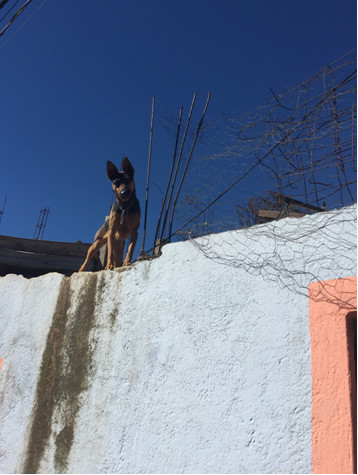
For a species that thrives on ranging with a pack, it's a sad fate indeed to be consigned alone to a patch of rectangle. And when one dog barks at 3:00 am, all the dogs in Guanajuato respond, and respond to the response, and so on. Our hotel room appears to be the best spot in town to enjoy this polyphony.
Here's what you might want to know about the Guanajuato Mummy Museum. Following a cholera epidemic in the 19th century a lot of people were buried very quickly in a geography that could be described as high altitude desert.
This sudden influx of bodies created a storage problem, and the government levied an annual interment fee on the burial plots. 'Death and taxes' is an expression that's probably universal, and in 19th Century Mexico the two weren't mutually exclusive.
If a family couldn't pay the annual fee, the loved-one's body was disinterred and thrown in a crypt. Due to the dryness of the climate the corpses didn't decay very much, and so were naturally mummified.
When we entered the display rooms there was a telling sign about taking photographs (one that I refrained from photographing for fear of incurring a curse.) The English version simply said "No flash my friend!" the Spanish translated as "Please do not use flash, it angers the mummies." Draw your own conclusions about cultural attitudes.
I think what upset me the most was the clothing. The mummies are frequently but arbitrarily clothed. Some have pants but no shirt; many have retained only footwear. The conclusion is inescapable. Clothing was removed whenever a live human discovered something in his or her size.
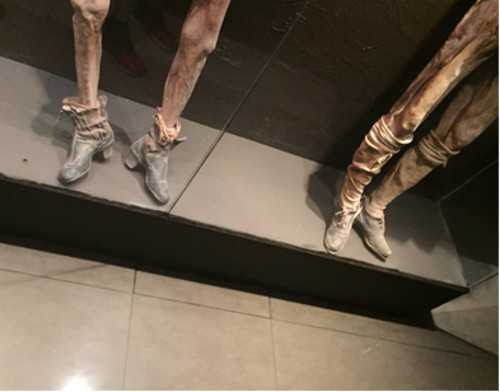
The museum was little more than an oddity before it became the shooting location for a 1972 grindhouse film called Santo Versus the Mummies of Guanajuato. This is actually an entry into the "Santo vs. __ " franchise (Santo vs. the Vampire Woman; Santo vs. the Daughter of Frankenstein. You get the idea.) There's even a mural celebrating the film (!) a few blocks from the museum.
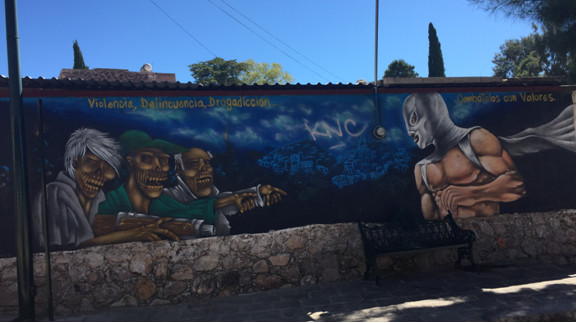
If my summary of Santo Versus the Mummies of Guanajuato is as brief as my summary of Sunrise is lengthy, that's because it's in the category of movies for which the collective mind of the audience has written an approximate version of the plot by the time it has finished reading the title.
Santo, incidentally, was an actual Mexican wrestler and in Mexico wrestling is a big deal. These guys are like rock stars here and I'll prove it. Spidermanlike, they wear full-head masks
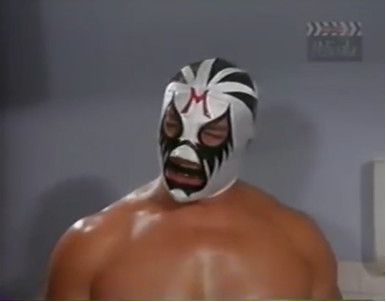
Allowing them to preserve anonymity, much as ...

...were able to do.
The mummy museum itself requires almost no commentary. You can't look at it look; you can't look away. Though that appears a bigger problem for me than for most people here, which I put down to cultural differences (see Octavio Paz excerpt at the head of this section.)
My spoken-Spanish comprehension is about 30 percent on good day and then only when I half know what to expect. So as the only non-Spanish speaker in the room I felt like the special kid being given a tour of the facility he's going to be placed in.
That X is translating the occasional pertinent detail for my ears makes me feel still more like the special kid. And the mummies add another level of intimidation. The look in their eyes is taunting. They know the secret of the other side, but they won't tell it to me.
At the hotel entrance - yes, I did make it back - I am met by a Don Quixote sculpture done rather like the Tin Man of The Wizard of Oz. I believe I look more Quixotic than the statue. Odd that a rear view of me found its way onto my camera. One of the mummies must have followed me, manipulated the iPhone out of my back pocket and taken it.
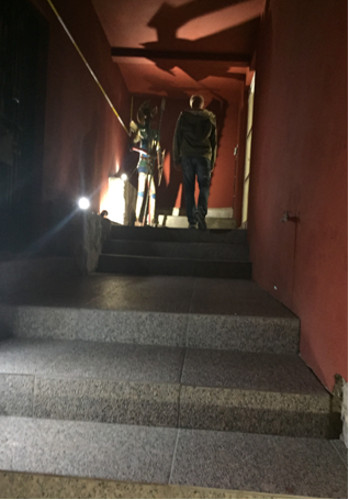
It's late in the day. As a station in my Mexico journey it roughly corresponds to passing the "Nobody's Perfect Bar and Grill," on my Sunrise Journey. Sure, any image of Quixote reminds us that the point of the journey is largely that we miss the point, or, as was ultimately the case for Quixote, that we discover it only on our deathbed.
JEFE: Do you know the works of Antonio Machado?
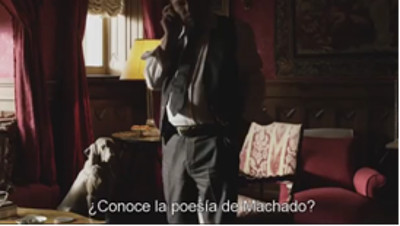
Rubén Blades in The Counselor, 2013
COUNSELOR: No. I know his name.
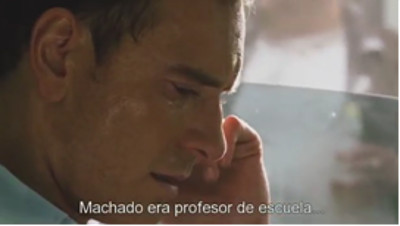
Michael Fassbender in The Counselor
JEFE: [...] He was a schoolteacher and he married a very beautiful young girl whom he loved very much. And she died. And so he became a great poet.
I was back in Hamilton. X was still in Mexico.
Like a lot of writers, much of my time is spent circling a patch of my apartment floor as a Guanajuato dog circles her flat roof. I kind of long for the hotel with the Escher steps now. It would give me a sense of accomplishment when I go in and out. But I live on the ground floor and simply move from one flat space to another
I'd emailed a rough draft of the Mexico section - amplified in some areas, attenuated in others - to Jeff Stewart, a poet from Hamilton now living in Winnipeg.
In return he sent me a remarkable poem he'd imitated freely from the Spanish of Machado
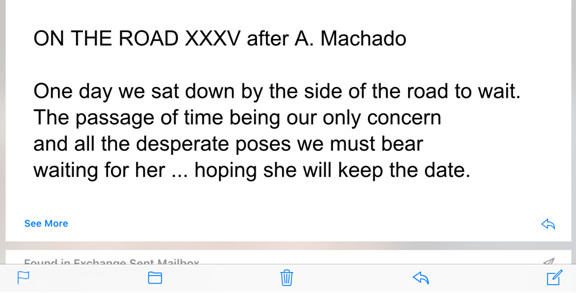
I like the double exposure of a Spanish poet and an English poet. I like that it's short enough to be easily rendered as a digital screen shot. It's to the photographed letterpress of the Octavio Paz excerpt what the Octavio Paz excerpt is to the scrawled Rexroth translation of Hitomaro. No more holding back the autumn leaves. I'm moving forward into state of the art communication.
I like the fact that Jeff is the person who introduced me to Robert Bruce. I like that JEFF lacks only the bottom bar of the last letter to become the JEFE of this section's epigram (Jefe is Spanish for 'employer', or more colloquially 'boss,' and yes, this can be a bit sinister and authoritarian, and sometimes that's what a writer is to a reader.) But mostly I like it because it describes the poses we assume, when forced to wait, as I'm waiting for X to come back from Mexico.
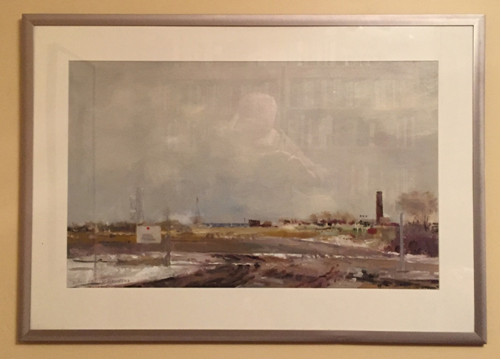
The above was painted by my father, Terry Fenton. He has a website you can easily check out with those coordinates. (I am promoting all kinds of people in this essay. What has gotten into me!)
I was with him when he took the photo it was painted from. It was an unbelievably cold day in a North Hamilton industrial location where Harbour Police are not, in my experience, keen on people standing and taking photos. But it was too cold even for them to come around.
You know that you're in 'impatiently waiting' mode when you find yourself shooting photos of pictures in your apartment. In fact if you look closely that's me reflected in the glass, between my bookshelves and a painting depicting a road into an industrial non-space mere blocks from where I'm now standing. It might be possible to create an image that makes me look more like a dog imprisoned on a roof in Guanajuato, but I don't know what that would be.
So, the feeling of being trapped is coupled with the directive of Antonio Machado/Jeff Stewart, to get on the road and see what poses it will force me into. And so I leap through the looking glass of my father's painting and find myself at the waterfront and here's what I see.
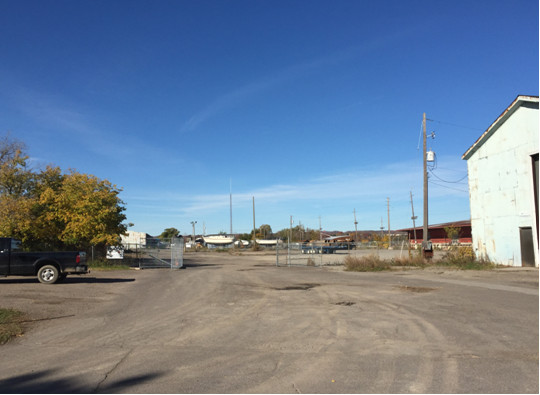
It's a different location than the painting, a different season, and a different media. But a picture is a self-contained thing that creates its own meaning, and the meaning of the painting and the meaning of the photograph are very similar. The same unbounded road, the same faint curve of tire tracks arcing to viewer - right, the same industrial width entrance that draws us in by gaping casually open but that at the same time repels us with its unreadable sign mounted on the fence to the left of the gate.
It's an uneasy mixture of invitation and exclusion. These aren't even negative spaces. It takes a supreme effort to see them as spaces at all and to put rectangles around them. My image is hasty and unremarkable compared to the painting, but the fact of a second, overlapping image taken quickly and carelessly constitutes a psychological double exposure.
It makes me look more closely at the first image, the one that a great deal more care was taken with. It's rather like a tourist visiting the setting of a favourite novel. However trivial the photographs the tourist takes, they amplify the power of the original creation.
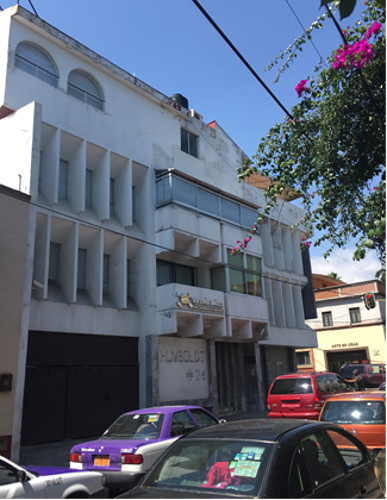
Like this picture I took of 24 Calle de Humboldt, Cuernavaca, Morelos, Mexico, which is the residence of Jacques Laruelle in Malcolm Lowry's Under the Volcano. My photo took only a few seconds of decision and execution; the novel took seven years to write.
But my visit and the photographs I took make the novel more vivid and more inscrutable. That I can inhabit settings for the novel underlines the fact that I can never enter the novel. The novel is finished, and self-contained in a way life never is.
Reaching the waterfront I looked outward, first to the factories,

a waning industry that refuseses to succumb to entropy any faster than it needs to, and that will be part of whatever comes after it, as our ancestors were for us.
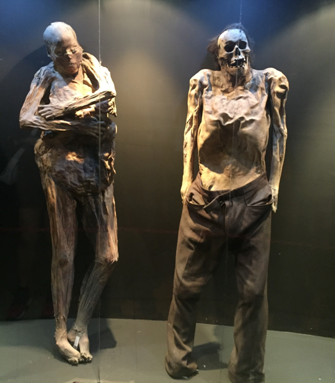
Mummies, Guanajuato
I suspect that as I'm wandering the waterfront like a zombie, randomly pointing my iPhone into air I satisfy a pose Machado/Stewart describe in their poem.
The boats don't tell me anything. I wish they'd bleat their horns to one another like the call and response of rooftop dogs. But they don't. They just look back at me.

I also wonder what I would look like to people on the ships. I have never left this city by boat. What do the people left onshore waving goodbye look like?
A few weeks ago I watched Letters From Home (1977) by the experimental filmmaker Chantal Akerman. It's a minimalist portrait of New York City, whose only spoken text is the voiceover of Akerman reading letters from her mother in Belgium. The final section is, I think you'll agree, more haunting post 9/11 than when it was shot, and for me more troubling still on 11/9. It's a view from the back of a ferryboat leaving south Manhattan, the skyline slowly shrinking. The following gulls are the only significant surface movement,
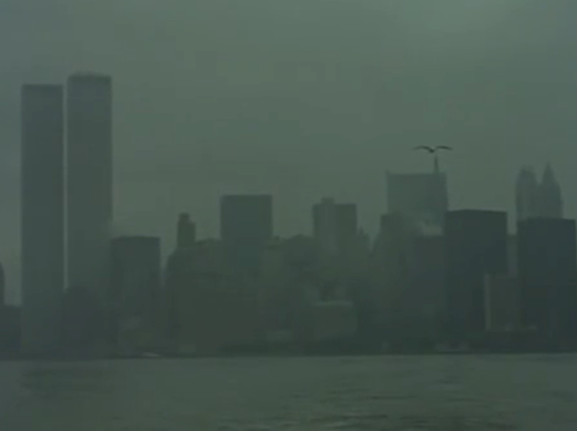
A few days later, I was watched Permanent Vacation (1980) an early feature film by Jim Jarmusch. Here's a still from its final moments.
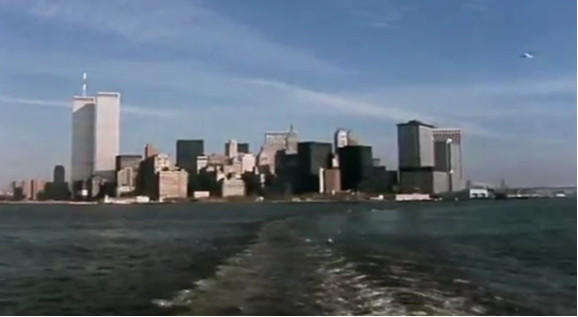
The Akerman/Jarmusch birds are probably different. But the mummified Akerman/Jarmusch towers are the same. Celluloid holds them as Hitomaro/Rexroth hold the leaves of autumn.
You must be logged in to comment.
There are no upcoming events right now.
Why not post one?